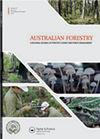Application of resistance drilling to genetic studies of growth, wood basic density and bark thickness in Eucalyptus globulus
IF 1.2
4区 农林科学
Q3 FORESTRY
引用次数: 11
Abstract
ABSTRACT Tree breeders are increasingly using resistance drilling (RESI) for the non-destructive assessment of wood basic density, but its application to the measurement of stem diameter at breast height (DBH) and bark thickness is less reported. Using Eucalyptus globulus progeny trials established with open-pollinated families from native trees representing 13 subraces, and adjusting bark thickness for its inherent phenotypic relationship with DBH, we: (1) quantified the genetic correlation between RESI and analogous traditional measurements of these traits; and (2) studied their genetic architecture and associations with subrace home-site climate. Significant variation was detected for all traditional and RESI-derived traits at the family and subrace level. High family and subrace-level correlations (>0.90) were found between RESI and traditional methods for all three traits. Bark thickness exhibited among the highest subrace differentiation (QST > 0.63) reported to date for E. globulus, signalling divergent selection. Increasing bark thickness was positively associated with home-site temperature annual range and seasonality. Although subrace differentiation for wood density (RESI and traditional measures) was less (QST = 0.18–0.21), a similar climate association was detected, and the subrace-level correlation with bark thickness was positive and significant (0.61–0.75). However, the non-significant correlations between bark thickness and wood density at the family level suggest that selective covariance rather than pleiotropy have caused the correlated patterns of subrace variation. Variation in bark thickness (adjusted) and wood density was independent of DBH at the family and subrace level. Given the importance of these traits, RESI provides a useful approach for non-destructive assessments for silvicultural, genetics and ecological studies of forest trees.阻力钻在蓝桉生长、木材基本密度和树皮厚度遗传研究中的应用
摘要树木育种人员越来越多地使用电阻钻孔(RESI)对木材基本密度进行无损评估,但其在测量树干胸径(DBH)和树皮厚度方面的应用报道较少。使用蓝桉子代试验,从代表13个子区的本地树木的开放授粉家族中建立,并根据其与DBH的固有表型关系调整树皮厚度,我们:(1)量化了RESI与这些性状的类似传统测量之间的遗传相关性;(2)研究了它们的遗传结构及其与亚空间生境的关系。在家系和子空间水平上,所有传统性状和RESI衍生性状都检测到显著变异。所有三个性状的RESI与传统方法之间都存在较高的家系和亚区水平相关性(>0.90)。到目前为止,球孢杆菌的树皮厚度表现出最高的亚区分化(QST>0.63),这表明了分化的选择。树皮厚度的增加与产地温度的年变化范围和季节性呈正相关。尽管木材密度的子空间分化(RESI和传统测量)较小(QST=0.18–0.21),但也检测到了类似的气候关联,并且子空间水平与树皮厚度的相关性是正显著的(0.61–0.75)。然而,树皮厚度与木材密度在家系水平上的不显著相关性表明,子空间变异的相关模式是选择性协方差而非多效性。树皮厚度(调整后)和木材密度的变化与DBH无关。鉴于这些特征的重要性,RESI为林木的造林、遗传学和生态学研究提供了一种有用的非破坏性评估方法。
本文章由计算机程序翻译,如有差异,请以英文原文为准。
求助全文
约1分钟内获得全文
求助全文
来源期刊

Australian Forestry
FORESTRY-
CiteScore
3.70
自引率
4.80%
发文量
15
审稿时长
>12 weeks
期刊介绍:
Australian Forestry is published by Taylor & Francis for the Institute of Foresters of Australia (IFA) for scientific, technical, and professional communication relating to forestry in the Asia Pacific.
 求助内容:
求助内容: 应助结果提醒方式:
应助结果提醒方式:


